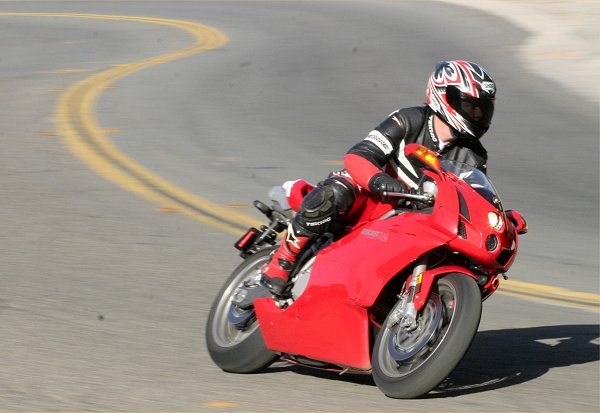
Italy. Things Italian. Whether it’s food, wine, art, cars, etc. there is flair, a richness and color not often found in anything similar. It makes resistance almost futile. Passion and feeling are as much a part of design as function for almost any object originating from this small, European country. Motorcycles are no different, and while the crew of Bologna has managed to apply fine art to motorcycles (remember the 916-998?), they also have created a ruthlessly competitive engineering package in their range of v-twins. Which brings me to the 2004 749S.

Power plant differences not withstanding, the 749S is identical to the 999, which debuted for the 2003 model year. All physical dimensions match up perfectly. Ergonomics are still very good, although current sportbike ergonomic trends will make the Ducati’s reach to the bars seem a bit long and a tad low. A few miles of acclimation will take care of that, but you are carrying a bit more weight on your wrists compared to the class competition (i.e., Japanese 600s).
The windscreen provides no protection to the rider, unless they are crawling under the paint in a racer’s tuck. From this tuck, you may be able to see behind you using the mirrors. Otherwise, you might as well consider them turn signals, since your elbows completely void the rear view, and that is where the signals are found.
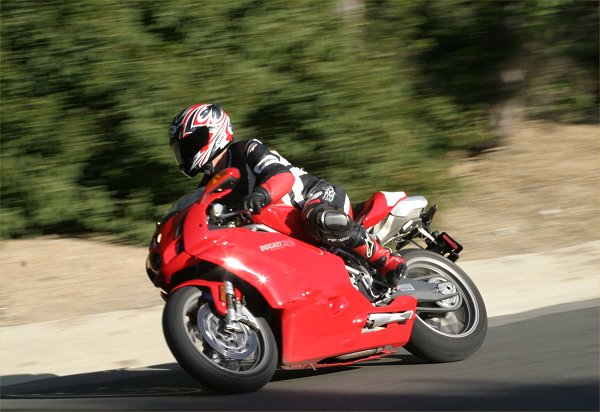
On the S model, riders can adjust seat position fore and aft in a 30mm range (monoposto only), and the footpegs have 5 positions available to accommodate a wider range of rider sizes. One part of the comfort quotient that seemingly has no importance is the seat. A not-so-thick rubber pad that comprises buttocks support feels pretty darn hard in the garage and gets harder as the miles roll by. Best to stay in the curvy stuff, so you don’t have time to think about that.
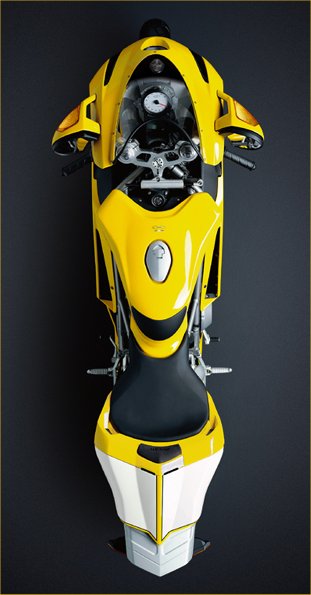
Handling is as I reported on the 999 during its Willow Springs introduction, that is, stable as a train, yet willing to change lines mid-corner with little effort and no drama. The 749S feels more eager to change directions than either the 999 or standard 749, due to the lighter crankshaft unique to this model. Still, it does not flick side to side like the current generation of Japanese middleweights. This is not necessarily a negative. The reduced sensitivity to input provides a more predictable and confidence inspiring feel.
If a more rapid steering response is desired, the S model’s steering head angle can be adjusted from a more relaxed 24.5 degrees to a sharper 23.5 degrees. On the brakes, it remains stable, with the longer swingarm reducing the tendency of the rear wheel to lose contact with the asphalt. Good for fast road riding and racing, bad for show-offs and stunters.
The brakes are Brembo, with the front radial master cylinder applying hydraulic force to the four-piston / pad caliper setup that squeezes the 320mm rotors. Despite the calipers not being radial-mounted, they do have a stiffening bridge that adds to caliper rigidity. Performance of the front brakes is in the same league with the latest and greatest stoppers coming from Japan, only losing out to the newest hardware during 10/10ths braking demands. Even so, they provide all the braking performance a rider is likely to ever need, until they roll out onto an AMA Formula Extreme grid.
The S model’s mill boasts a few key changes from the standard 749 to gain more ponies. The aforementioned crankshaft lightening, a bump in compression ratio (11.7:1 to 12.3:1), one-millimeter larger intake valves (38mm vs. 37mm), and lighter opening rocker arms work with more aggressive cam profiles to yield greater valve lift on both intake and exhaust. Claimed horsepower increases from the standard 749’s 103 hp to the S-model’s 110 hp, while torque sees only a slight increase.
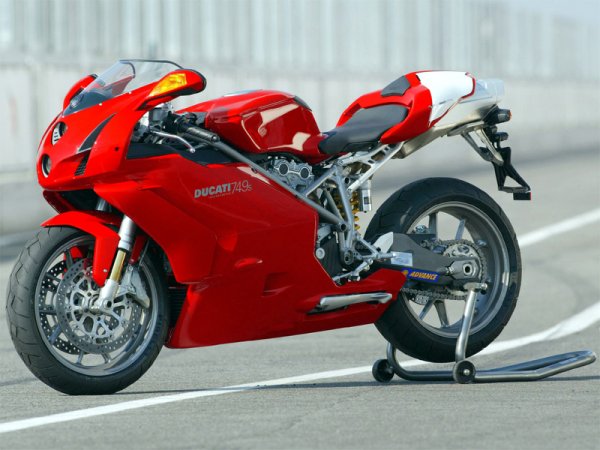
On the road, the engine issues an attention-getting baritone note through the underseat exhaust, which accompanies the smooth, torquey acceleration that is trademark behavior of a v-twin, and Ducati in particular. The v-twin, having comparatively fewer firing pulses, finds traction in both dry and wet situations that might have the inline-four competition spinning its back wheel. Naturally, the 749’s engine does not hit as hard as its bigger brother, but because of this, there is less low-rpm shuddering under acceleration, and the engine feels smoother and revvier, which could be due more to the lighter crank. Acceleration is near its 600-class competition, but it won’t quite run with the newest of the new.

The transmission performed flawlessly, providing quick, accurate and light-action shifts, with or without the clutch. Internal ratios are shared among the 999s and 749s with only final drive gearing (15/36 – 14/39, respectively) being tailored to each model. Speaking of the clutch, it is a hydraulic actuation, dry unit like the 999’s. On the street it worked well, with average pull at the lever, although it protested audibly under high(ish) rpm standing starts. Repeated quick starts will cause it to overheat and become grabby. It might be a good idea to have a spare set of plates standing by in the garage.
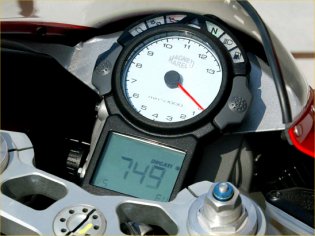
In the suspension department, 43mm Showa upside down forks receive a TiNitride coating on the lower stanchions and out back the rear shock is a higher spec Showa unit, vs. the standard model’s Sachs unit. Suspension action was very good, with standard settings providing a good compromise between compliance and composure. This was fortunate, since there were no tools present to adjust the shock preload in the tool kit. Adjusting damping settings front and rear revealed noticeable changes. The useful range of adjustment should be able to accommodate just about any rider and situation with a little roadside fiddling.
Instrumentation is the same as the 999, using a CAN (control area network) digital system to reduce the number of wires from dozens to just a few, with only two finding their way to the smartly styled and very informative instrument cluster. In addition to the usual information, you also get a lap timer, adjustable shift light, and real-time fuel mileage readout. Coasting in neutral down the tight side of a popular SoCal road at about 45 mph, I was achieving 120 mpg!
Fit and finish of the new generation Ducati is very good, and everything works well for the rider, just don’t expect long-range comfort. That’s okay, though, because while you’re taking a break from the seat, you can admire the new bodywork that artfully and beautifully covers the underpinnings that make this motorcycle so fun and rewarding to ride. As far as MSRP goes, like most other things Italian, it does come at a high price. At $14,795, buying a 749S after comparison-shopping with its Japanese competition will almost certainly be based on emotion, character and beauty, rather than performance numbers, but these factors can bear plenty of weight in the decision making process of wealthier motorcycle enthusiasts. Can’t say that I blame them.






